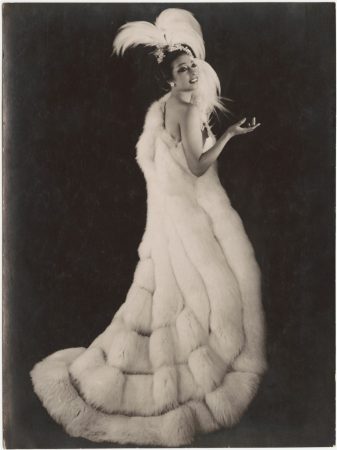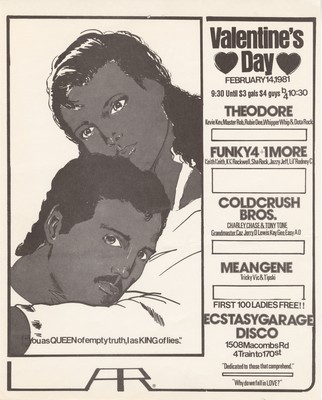In honor of Black History Month, we have consolidated a list of collections available in JSTOR’s freely available community-contributed collections. We invite you to explore the resources – historic chronicles from manuscripts, newspapers, documents and recordings, the story of African American art told by the works themselves, photographic archives portraying the lives of celebrated African Americans and those we no longer know. Discover great works, official records, iconic portraits, ephemera and memorabilia in the collections below.
Blog Search results: african
Celebrations of light
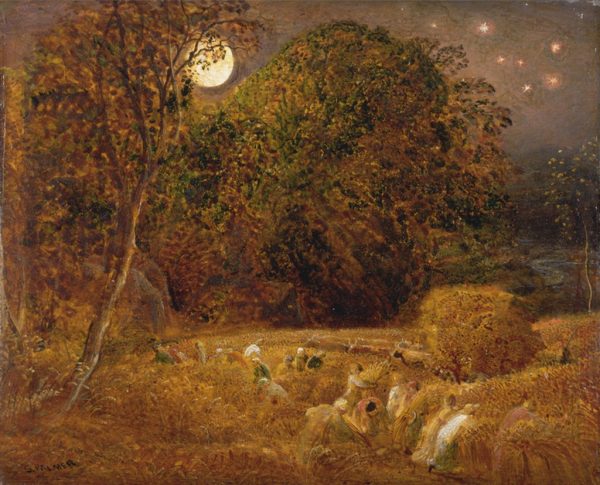
Samuel Palmer. The Harvest Moon. c. 1833. Image and data from the Yale Center for British Art, Paul Mellon Collection.
As the strength of the sun wanes in the fall, our festivities and rites tend to be centered on the elements of fire and light — natural, divine, and synthetic. It is no accident that many of our brightest celebrations light up our darkest months. Below, we have selected some images that collectively exalt the power of light to animate our revels.
Giving thanks

Bob Gore. Giving Thanks, Terrier Rouge, Haiti. 10 Oct. ‘07. Image and data from Bob Gore Productions, Inc.
We are on the cusp of the holiday season, a quiet, delicious pause before the big rush — a time when we slow down to reflect and give thanks. In the spirit of A.A. Milne’s inimitable philosopher Piglet, we may recall our capacity for gratitude: “Piglet noticed that even though he had a Very Small Heart, it could hold a rather large amount of Gratitude.” In celebration of Thanksgiving, we are highlighting expressions of thanks through time and across the world.
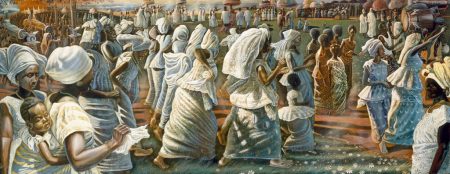
John Biggers. Jubilee Ghana Harvest Festival. 1959-1963. Image and data from the Museum of Fine Arts, Houston. © John T. Biggers Estate Licensed by VAGA, New York, NY.
A moment of grace bestills the bowed heads of three small Haitian girls captured by the photographer Bob Gore, while a swell of Ghanian women is moved by thankful joy during a Harvest Festival in a monumental painting by the African American artist John Biggers.
Celebrating Juneteenth with quilts: sewing freedom, unity, and joy
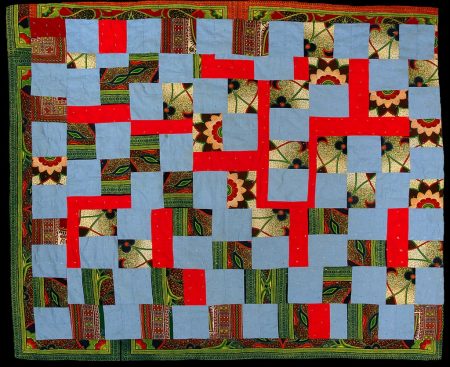
America Irby. Quilt. Image and data from The Museum of Fine Arts, Houston. © 2016 Artists Rights Society (ARS), New York.
We was taught there’s so many different ways to build a quilt. It’s like building a house. You can start with a bedroom over there, or a den over here, and just add on until you get what you want. Ought not two quilts ever be the same. You might use exactly the same material, but you would do it different. A lot of people make quilts just for your bed, for to keep you warm. But a quilt is more. It represents safekeeping, it represents beauty, and you could say it represents family history. 1
Mensie Lee Pettway (b. 1939), on learning her craft from her mother America Irby.
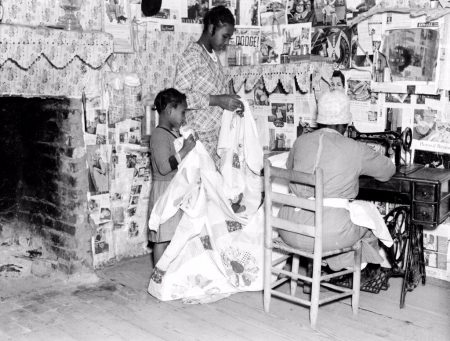
Arthur Rothstein. Jennie Pettway and another girl with the quilter Jorena Pettway. 1937. Image and data from The Library of Congress.
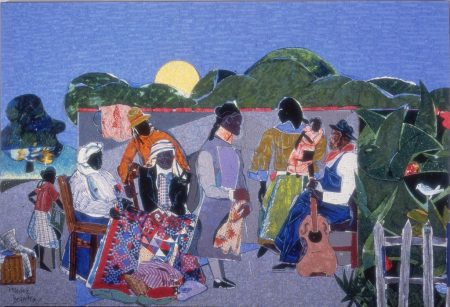
Romare Howard Bearden. Quilting Time. 1985. Image and data from the Detroit Institute of Art. Art © Estate of Romare Bearden / Licensed by VAGA, New York.
Juneteenth is an annual holiday commemorating the end of slavery in the United States, and we are celebrating with a virtual exhibition of African American quilts. June 19 observes and renews the call for freedom, justice, and equality in the African American community. From the period of slavery through emancipation and up to current times, the activities and output of quilters have embodied strength, bound the community, and bestowed beauty and warmth, echoing the spirit of the holiday. An archival photograph of two generations of the Pettway family sewing together, 1937, and the mosaic mural Quilting Time, 1986, by Romare Bearden attest to the community building/family bonding attributes of the tradition.
Broadening horizons: JSTOR collections 2020-2021
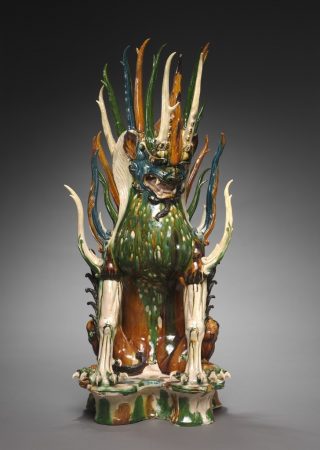
Tang Dynasty. Tomb guardian. early 700s. Glazed earthenware. Image and data from The Cleveland Museum of Art. CC0 1.0.
Extending our cultural scope and disciplinary reach
We are working to add new collections that extend JSTOR’s cultural scope and disciplinary reach. This includes African, African American, and Asian content, and content in disciplines such as social justice and human geography, environmental studies, public health, and natural sciences. New additions centered on this growing diversity include: Barbara Anello: Photographs of Khmer Sites and Monuments; Arthur Szyk; Magnum Photos, and more.
The Arthur Szyk collection
A landmark offering of 500 new images by one of America’s most celebrated political artists during World War II.
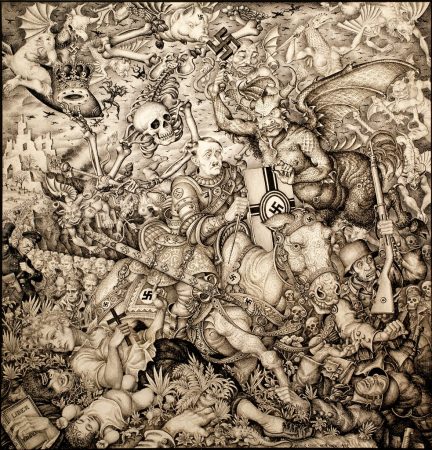
Arthur Szyk, Walpurgis Night. New York, 1942. Pen, ink and colored graphite on paper. Image and original data provided by Irvin Ungar.
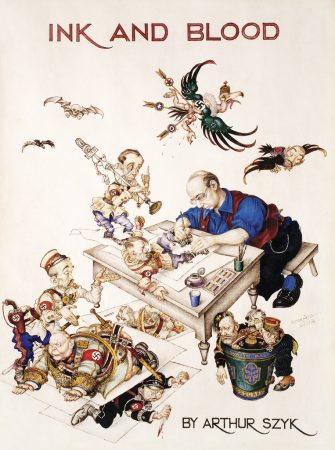
Arthur Szyk, Ink and Blood (Self-Portrait). New York, 1944. Watercolor and gouache on paper. Image and original data provided by Irvin Ungar.
Scholar and author Irvin Ungar has recently contributed the Arthur Szyk collection to Artstor, consisting of 500 images by acclaimed World War-II era Polish-Jewish artist Arthur Szyk (b. 1894, Łódź, Poland – d. 1951, New Canaan, Connecticut). Below, Ungar and art historian Samantha Lyons, PhD, provide context on the artist’s life and career.
11 open collections perfect for Hispanic Heritage Month
By now you know that Artstor’s Public Collections provide approximately 1.3 million freely accessible images and other materials from library special collections, faculty research, and institutional history materials. The collections are constantly growing, and as we browsed for Latin American content in preparation for Hispanic Heritage Month, we were delighted by what we found. Here are some notable highlights:
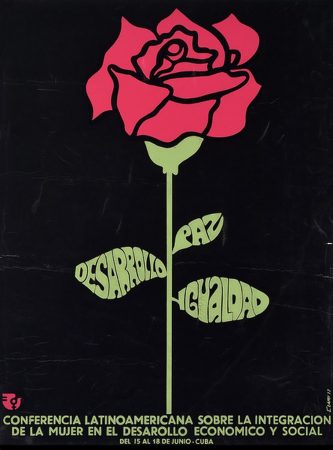
Clary. Conferencia Latinoamericana Sobre la Integracion de la Mujer en el Desarollo Economico y Social. 1977. Image and data from Wofford College: The Lindsay Webster Collection of Cuban Posters.
Wofford College: The Lindsay Webster Collection of Cuban Posters
The collection features approximately 350 works created in Cuba from the revolution through the 2000s. Many of the posters focus on Cuba’s efforts to spread messages of the revolution worldwide and to inspire others in the fight against oppression stemming from the legacies of imperialism and colonialism, as well as posters focused on promoting Cuban national pride, conservation, production, and culture.
Dartmouth: Ediciones Vigia Collection
In 1985, a Cuban poet Alfredo Zaldivar and an artist Rolando Estevez established a literary forum for a group of Cuban artists in Matanzas, Cuba and called it Ediciones Vigía. For over twenty years now the goal for these artists has been to create beautiful handmade books. Through all of the social and political shifts, and even a severe paper shortage, the artists have found ways to create works of enormous artistry, imagination, and creativity by using found and recycled materials.
Teaching and research with Artstor: 25 examples
Over the years, educators, librarians, and researchers at all levels, from secondary schools to graduate programs, have shared with us how they use Artstor in their teaching and research. We’ve gathered some of our favorites here, touching on topics as varied as medicine, ethnic studies, women’s studies, and more.
Would you like to share how you use Artstor? Leave a comment and we’ll follow up!
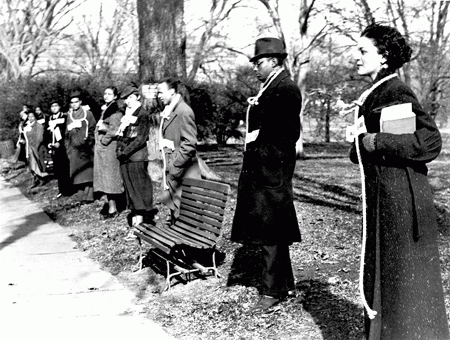
Unknown photographer. Howard University students picket the National Crime Conference, December 1934. Eyes of the Nation: A Visual History of the United States (Library of Congress)
Washington’s secret city: cultural capital
Amber N. Wiley, Ph.D., Visiting Assistant Professor of Architecture, Tulane University
Race, identity, and experience in American art
Dr. Jennifer Zarro, Tyler School of Art, Temple University
New: Open The Cleveland Museum of Art
Explore one of our finest museums virtually
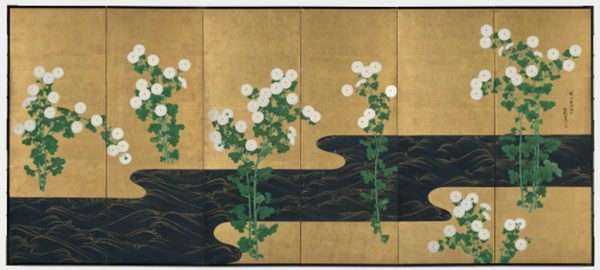
Ogata Korin, follower of. Chrysanthemums by a Stream. Late 1700s – early 1800s. One of a pair of folding screens; ink and color on gilded paper. Image and data provided by The Cleveland Museum of Art. CCO 1.0.
In collaboration with The Cleveland Museum of Art and their comprehensive Open Access initiative, Artstor has published an expansive selection of works from this leading repository, freely available to all and with Creative Commons licenses in Open: The Cleveland Museum of Art. Incorporating more than 10,000 years of history and iconic works from every corner of the globe, this collection includes nearly 29,000 images offering considerable coverage of the museum’s encyclopedic collection — paintings from Nicolas Poussin to Georgia O’Keeffe, precious jewels and scrolls from China, Japanese screens and kimonos, African and Native American ritual attire and objects, pre-Columbian gold, photography, and much more.
American art at the Indianapolis Museum of Art at Newfields
Dr. Kelli Morgan, Associate Curator of American Art at the Indianapolis Museum of Art (IMA) at Newfields introduces us to some of the American gems in the IMA’s collection.
The American collection at the Indianapolis Museum of Art at Newfields (IMA) is an encyclopedic group of brilliant objects that span US history from the Colonial period to the 1970s. The collection is well known for its American Impressionism, modernist painting and sculpture, and of course Indiana’s own Hoosier School. Yet, IMA’s American collection is comprised of such a diverse array of objects that it offers an alternative look at the American canon.


